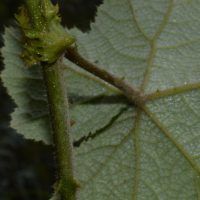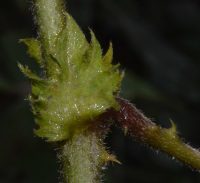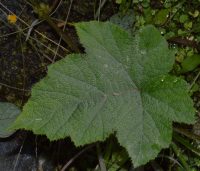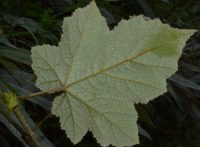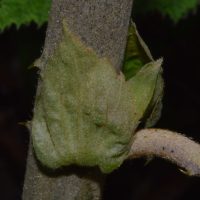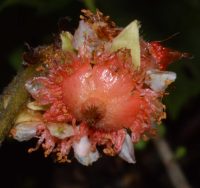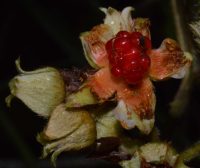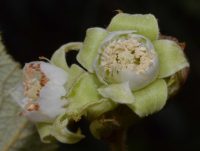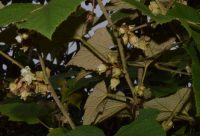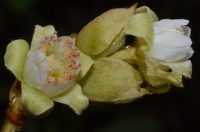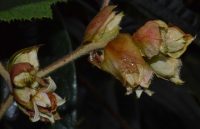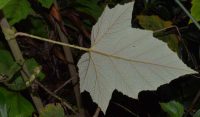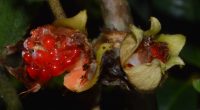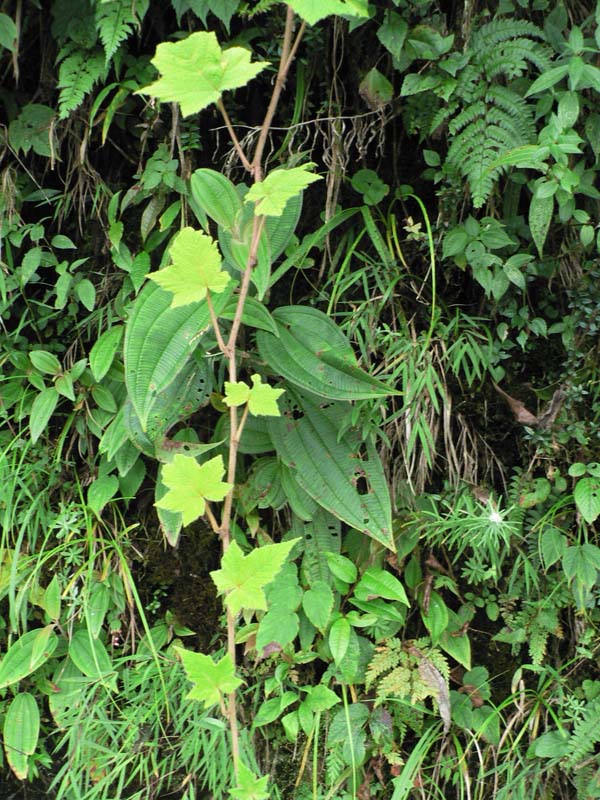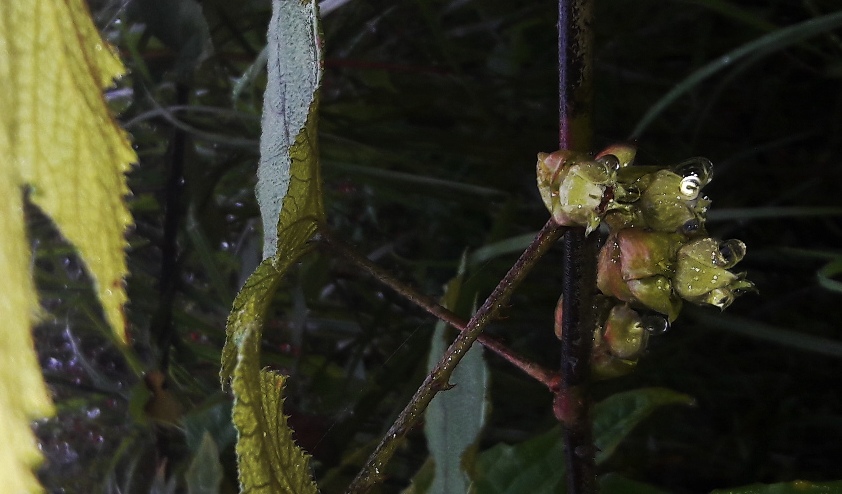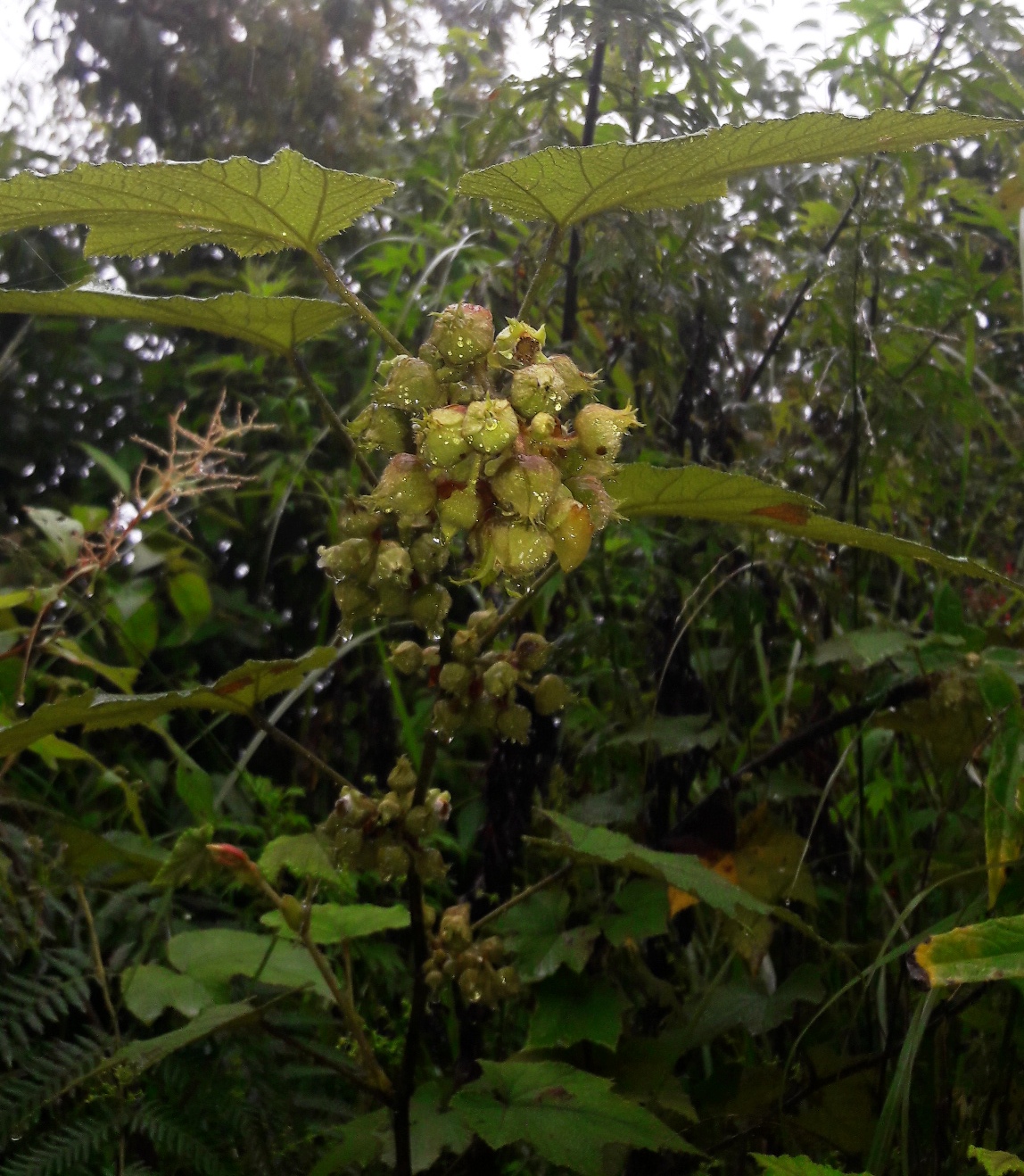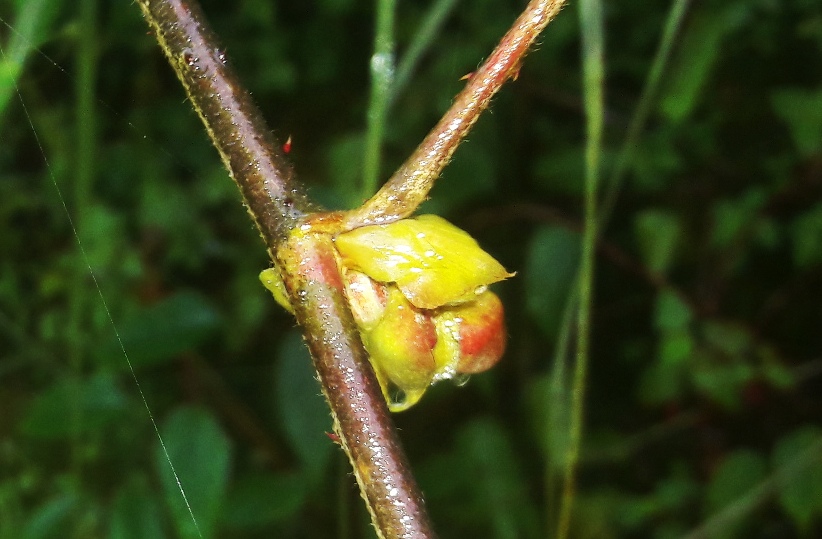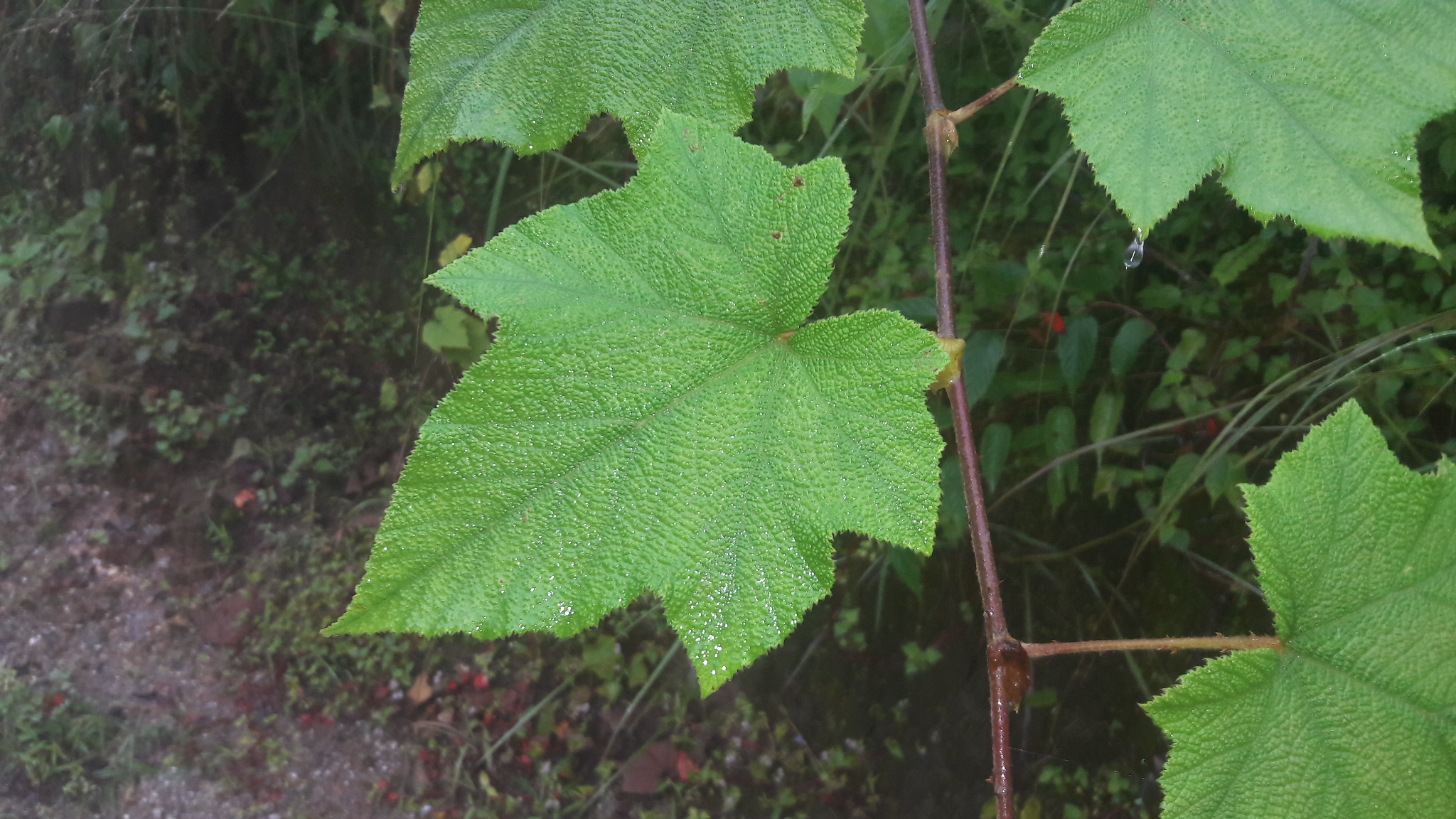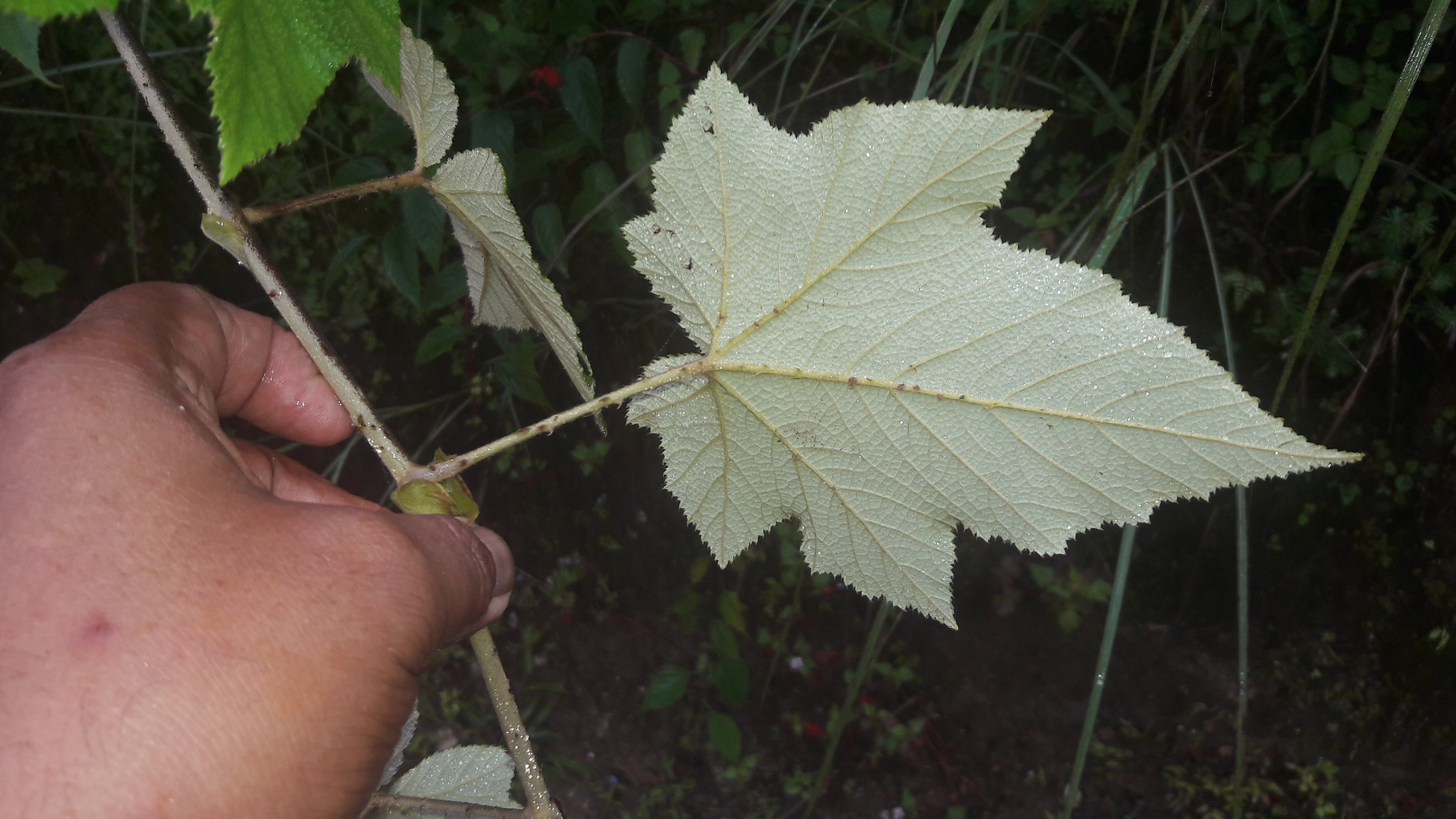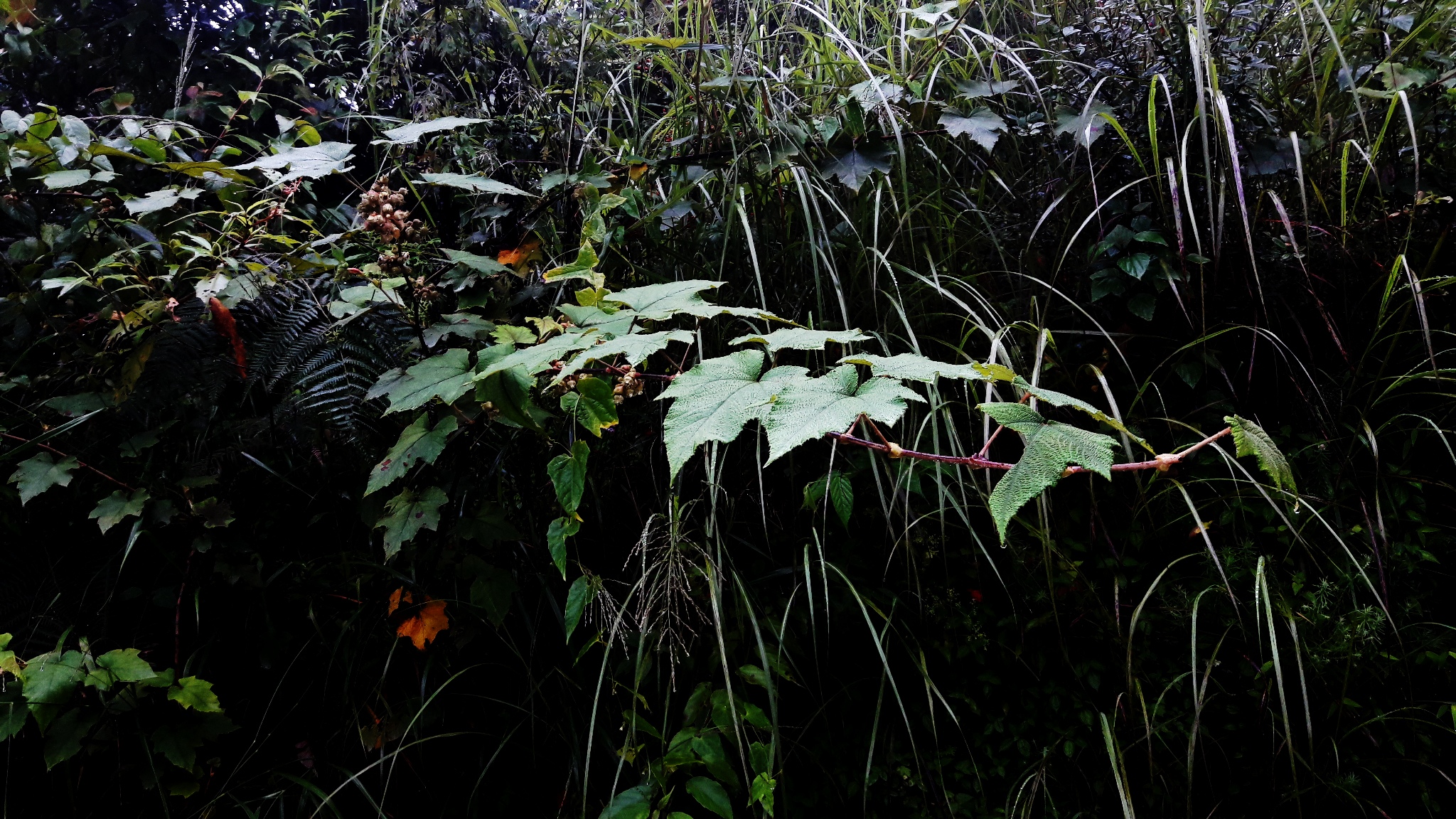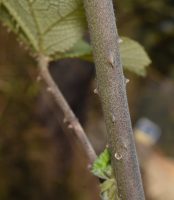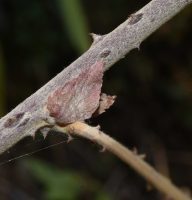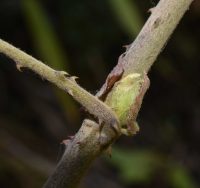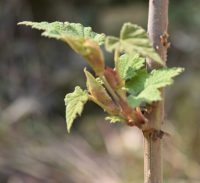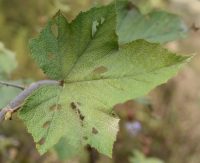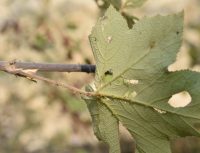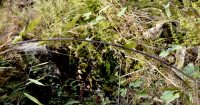|
Rubus calycinoides Kuntze, Meth. Sp. Rubus 67, 78 & 83 (1879). (syn: Rubus bhotanensis Kuntze; Rubus darschilingensis Kuntze; Rubus diffisus Focke; Rubus fallax Kuntze; Rubus himalaicus Kuntze; Rubus moluccanus var. calycinoides (Kuntze) Kuntze; Rubus subherbaceus Kuntze);
.
Nepal, N-India, Bhutan, Sikkim, Darjeeling as per Catalogue of Life;
I checked in GBIF also. Pl. see specimens from India and Nepal for R.calycinoides and R. rugosus
Flora of Bhutan gives the following keys:
Leaves 10—20cm long and broad, lobes acute; stipules 1.5-2cm, subpersistent; pedicels 8- 15mm; calyx lobes 10-12mm, often toothed ….. 16. R. calycinoides
Leaves 8-12X6-10cm, lobes rounded or subacute; stipules 1-1.5cm, early caducous; pedicels 2-7mm; calyx lobes 8—9mm, entire or minutely toothed at apex … 17. R. rugosus I think lobes acute in R.calycinoides and rounded or subacute in R. rugosus, may be one of the major differences.
. Large scrambling shrub, stems brownish pubescent and with scattered short recurved prickles, eglandular. Leaves broadly ovate or suborbicular, 10-20cm long and broad, base cordate, 3-5-lobed or with a few additional minor lobes, lobes acute, sharply serrate, stiffly pilose to subglabrous and often rugose above beneath; petioles 4-9cm, with recurved prickles; stipules ovate, 1.5-2cm, deeply toothed or laciniate, often persistent. Flowers in axillary clusters oe short racemes up to 6cm. Pedicels 8-15mm. Bracts elliptic, 1-1.5cm, toothed at apex. Calyx lobes triangular, 10-12mm, brownish or yellowish sericeous, often toothed on margins. Petals white, equalling calyx lobes. Fruits red, drupelets 40-50. Fl. June-August
Subtropical and warm broad-leaved forest margins.
(Attributions- A.C.J Grierson & D.G Long. Flora of Bhutan. Published by RBGE. 1987)
.
Location: Tarakeswar, Okharpauwa, Kathmandu
Date: 17 October 2019
Elevation: 1471 m.
Habit : Wild
Some friend suggested Rubus kumaonensis N.P.Balakr. !
Please note the shape of stipule and down pointing spikes.
Attachments (1)- 1 mb.
Attachments (1)- 7 mb. Attachments (1)- 7 mb. Keys in Flora of Nepal – online account, lead me to Rubus calycinus
Pl. check in GBIF and other references at Rubus calycinus
No … R. calcynus is creeping herb but it is climbing erect shrub.
Being a shrub, I reworked with keys in Flora of Nepal – online account, which lead me to Rubus calycinoides.
It seems to match as per specimen in GBIF. Also see another specimen. Thank you … I cross checked with FoN. Location: Chisapani, Kathmandu
Date: 01 October 2019
Elevation: 2103 m.
Habit : Wild Which Rubus ?
Attachments (3)- 1, 2 & 3 mb. Attachments (4) – 1 mb each.
Attachments (2)- 1 & 4 mb.
Attachments (1) – 4 mb. Attachments (1) – 7 mb.
Attachments (1) – 6 mb. Both R.rugosa and R.calycinoides both appear quite close as per keys in Online Flora of Nepal
However, I feel it is more closer to R.calycinoides rather than R.rugosa, due to
1. Habit being Erect and arching compared to climbing and scandent of R.rugosa
2. Stipule being lacerate
3. Fruiting period being Oct.- Dec. compared to July to Sept. of R.rugosa
Thank you … I cross checked with FoN. … email on Creepers reminded me that two creepers remained unposted for ID. Here is the first one. Looks like Ampelocissus tomentosa form Vitaceae Can not say with this images weather it is Ampelocissus tomentosa (B.Heyne & Roth) Planch. or some other species. Looks like Rubus calycinoides Kuntze !
Rubus 240715SP1-3 : 4 posts by 3 authors. Attachments (3)
I need species level identification of following 3 images of Rubus sp. To me it seems to be Rubus moluccanus. (Ref. Edible Wild Plants of The Himalayas,1964/R L Badhwar and R R Fernandez) I think yes, R. maluccanus This may also be Rubus calycinoides as per discussions in Rubus 020815SP1-2 Yes … ! Rubus 020815SP1-2 : 9 posts by 4 authors.
I need species level identification of following 3 images of Rubus sp. Rubus species in eFloraofindia (with details/ keys from published papers/ regional floras/ FRLHT/ FOI/ Biotik/ efloras/ books etc., where ever available on net) This white flowered Rubus seems to be R. floribunda As per GRIN Rubus floribundus Kunth, does not occur in India in wild. Looks like Rubus moluccanus L. Thank you again … I didn’t even see a simple leaved rosaceae! To me it seems to be Rubus moluccanus. I think it may be Rubus calycinoides as per images and details herein and as per keys in Online Flora of Nepal.
I think the keys above clearly do not bring out the difference properly as neither margins are not entire in R.rugosus nor the apexes is as mentioned above in both the species. Flora of Bhutan gives the following keys:
Leaves 10—20cm long and broad, lobes acute; stipules 1.5-2cm, subpersistent; pedicels 8- 15mm; calyx lobes 10-12mm, often toothed ….. 16. R. calycinoides
Leaves 8-12X6-10cm, lobes rounded or subacute; stipules 1-1.5cm, early caducous; pedicels 2-7mm; calyx lobes 8—9mm, entire or minutely toothed at apex ….. .. 17. R. rugosus I think lobes acute in R.calycinoides and rounded or subacute in R. rugosus, may be one of the major differences. Yes … Rubus indicus Thunb. : 14 posts by 3 authors. Attachments (7)
Sharing some pictures of Rubus indicus (I guess) shot at Nagarkot on 13 August 2016 at 7000 ft. These matches with images of the same species by … at
Rosaceae Fortnight :: Rubus indicus :: Eravikulam National Park :: DVSEP20 I am a little confused about the differences between Rubus indicus and Rubus moluccanus. Can some one explain? Thanks, … The following links may be of some use in this matter:
Is this the same plant ? Pictures were shot at Kakani Nepal on 29 July 2016 at 6000 ft.
Appears so. As a non botanist , I try to identify plants with plates given in books. I have got two books on plants of India. These are, (a) THE USEFUL PLANTS OF INDIA (CSIR Publication)
(b) EDIBLE WILD PLANTS OF THE HIMALAYAS (R L BADHWAR AND R R FARNANDEZ, Forest Research Institute)
In these books there is no mention of Rubus indicus. But Rubus Indicus is there in Google.
In both the above mentioned books Rubus moluccanus is mentioned. This is how the plant is described in book at (b)
“A prickly shrub. Leaves 5-20 cm across, digitately 3-7 lobed, with wrinkled upper surface; edges toothed. Flowers white, 1.2-2.5 cm across. Fruit round, fleshy, red or scarlet.
Distribution: Himalayas from Kumaon to Sikkim at altitudes of 900- 2100 m and in Assam up to 1950 m.
Season : All the year round “
As per book at (a) the plant is known as KATSOI (Kumaon), SUFOKJI (Lepcha) and BIPEN KANTA (Nepal).
To me the images sent by … is of Rubus moluccanus and not of Rubus indicus. According to the following links all 4 names looks synonyms. As such, we can take it as R. rugosus as listed in Nepal publications.
Any further enlightening is welcome.
As Catalogue of Life 28th July 2016, Rubus moluccanus L. does not have any distribution in India, while it gives distribution of Rubus indicus as per link. Frankly, I had gone by the placard at Eravikulam National Park.
My two posts in this group are:
Rosaceae Fortnight :: Rubus indicus :: Eravikulam National Park :: DVSEP20
I too am not clear about relation/ difference between R. indicus and mollucanus. Shall we say facts given in a publication of CSIR and a publication by Forest Research Institute are wrong?
In that case some one should apprise them about the misinformation so that non botanists are enlightened. When were these books published ?
Lot of changes has happened in the recent past due to rapid changes in taxonomy.
Rubus moluccanus in view of discussions in the thread. Adding some fresh pictures of the same plant for the final verdict on it. Attachments (10) Thanks, … We have already decide on following the name Rubus moluccanus I think it may be Rubus calycinoides as per images and details herein and as per keys in Online Flora of Nepal. Yes … Location: Shivapuri National Park,Nepal
Date: 25 August 2018
Elevation: 5800 ft.
Habit : Wild Rubus rugosus Sm. ??
I think looks somewhat different at first glance at
Ok … I shall check. Rubus treutleri Hook.f. ??
I think looks different from images at
On scrutiny of all threads in efi site, I think it is closer to Rubus moluccanus only.
Thank you …!.
In Nepal books it is listed as Rubus rugosus Sm. but leaf pattern and rugosus pattern looks somewhat different. I find some Rubus sp. are really very difficult to identify properly.
Species Rubus rugosus Sm. 1st image in Rubus moluccanus in FOI : 6 posts by 3 authors.
1st image in Rubus moluccanus in FOI looks to be from some different species.
I have removed the first image for now. I will have a closer look at it. I think it may be Rubus calycinoides as per images and details herein and as per keys in Online Flora of Nepal. Yes … Rubus rugosus Sm. : 7 posts by 3 authors. Attachments (6)
Location: Nagarkot, Nepal
Date: 12 December 2017
Altitude: 6800 ft.
It may be Rubus rugosus Wight as per Rubus moluccanus Thank you …!
Nepali Names : मरेठी Marethee / जोगी ऐंसेलु Jogee Ainselu / गोरु ऐंसेलु Goru Ainselu / बन ऐंसेलु Ban Ainselu / बिपेम काँटा Bipem Kaantaa
I am confused about the color of fruit. It should be black, isn’t it ? As per the net fruit color matching with R. moluccanus.
there may be some fungus infection. did you get them examined by some lab??? Rubus rugosus Wight is a syn. of Rubus moluccanus I am confused about the color of fruit. It should be black, isn’t it ? As per the net fruit color matching with R. moluccanus.
there may be some fungus infection. did you get them examined by some lab??? Rubus rugosus Wight is a syn. of Rubus moluccanus Can this also be R.calycinoides as per SK 2297 18 November 2019 due to fruiting in Dec. ? This species is stated to be erect or arching. Rubus rugosus Sm. I think it may be Rubus calycinoides as per images and details herein and as per keys in Online Flora of Nepal. Yes … It would be interesting to know Key and description of two species R. calycinoides Kuntze and R. rugosus Sm. because R. calycinoides Hayata and Koidz. (considered now as synonym of R. rolfei S. Vidal, along with R. pentalobus) is a very popular ground cover plant and amply described in numerous garden websites. Got it from our own website, thanks … Flora of Bhutan gives the following keys:
Leaves 10—20cm long and broad, lobes acute; stipules 1.5-2cm, subpersistent; pedicels 8- 15mm; calyx lobes 10-12mm, often toothed ….. 16. R. calycinoides
Leaves 8-12X6-10cm, lobes rounded or subacute; stipules 1-1.5cm, early caducous; pedicels 2-7mm; calyx lobes 8—9mm, entire or minutely toothed at apex … 17. R. rugosus I guess it is different from R. calycinoides ! Any further opinion on this about Rubus rugosus Sm. ? Nepali Names : गोरु ऐँसेलु Goru Anselu / बिपेन काँडा Bipen Kaanda
1 attachment. SK766 29 SEP-2017:ID : 6 posts by 3 authors. Attachments (7)
Location: Lakeside, Pokhara, Nepal
Date : 13 August 2017 Altitude : 2600 ft. Rubus indicus Thunb. ?? FoI
Rubus rugosus Sm. ?? FoI and ACLoN, Book of Nepal
Rubus hamiltonianus Ser. ?? ACLoN, Book of Nepal
Rubus moluccanus L. ?? Book of Nepal
Rubus wightii Gamble ?? FoI
Rosaceae. Also check in efi site. Beautiful images. I thought we have sorted out this issue in Rubus indicus or Rubus moluccanus or both
Pl. see more details at Rubus moluccanus I think it may be Rubus calycinoides as per images and details herein and as per keys in Online Flora of Nepal. Yes … . Rubus calycinoides Kuntze: Location: Kathmandu, Central Nepal If you look at this GBIF link, thumbnails are named under around 8 species (which are shown as syn. of Rubus calycinoides Kuntze in GBIF in the left panel).
Taxonomy is a bit complex here. confusion is because two distinct species have been named as Rubus calycinoides Hayata ex Koidz. is a creeping mat-formimg ground cover, nearly rounded leaves, mostly shorter than 5 cm, shallowly 3-5 lobed with white underside, now correctly known as R. rolfei S. Vidal, with R. pentalobus Hayata also as as synonym. … email on Creepers reminded me that two creepers remained unposted for ID. Here is the first one. Looks like Ampelocissus tomentosa form Vitaceae Can not say with this images weather it is Ampelocissus tomentosa (B.Heyne & Roth) Planch. or some other species. Rubus calycinoides Kuntze ! . Rubus calycinoides Kuntze: 4 very high res. images. Location: Harthok, Palpa
Altitude: 1460m.
Date: 31 August 2021
Habit : Wild . Rubus calycinoides Kuntze: 8 very high res. images. Location: Panchase, Pokhara, Nepal
Date: 14 March 2024
Elevation: 882m.
Habitat: Wild .
Location: Panchase, Pokhara, Nepal
Date: 14 March 2024
Elevation: 882m.
Habitat: Wild Can you point out where such a variation in stipules is listed as the difference?
I think lobes acute in R.calycinoides and rounded or subacute in R. rugosus, may be one of the major differences.
Can you point out where such a variation in stipules is listed as the difference in the books/ descriptions etc.?
I will go for Rubus calycinoides Kuntze only.
. References: |
Rubus calycinoides
Updated on December 29, 2024

